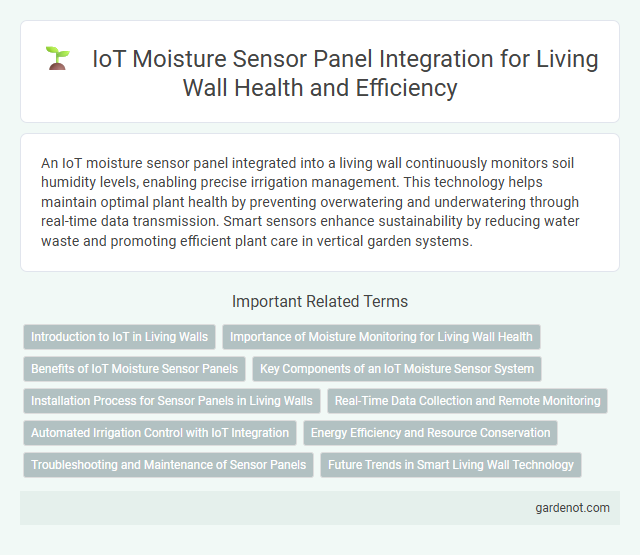An IoT moisture sensor panel integrated into a living wall continuously monitors soil humidity levels, enabling precise irrigation management. This technology helps maintain optimal plant health by preventing overwatering and underwatering through real-time data transmission. Smart sensors enhance sustainability by reducing water waste and promoting efficient plant care in vertical garden systems.
Introduction to IoT in Living Walls
IoT moisture sensor panels revolutionize living wall maintenance by providing real-time soil moisture data, ensuring optimal hydration for plant health. These sensors connect wirelessly to smart systems, enabling automated irrigation adjustments that conserve water and promote thriving greenery. Integrating IoT in living walls enhances sustainability while reducing manual monitoring and maintenance efforts.
Importance of Moisture Monitoring for Living Wall Health
Moisture monitoring ensures optimal hydration levels for living walls, preventing both underwatering and overwatering that can lead to plant stress or disease. IoT moisture sensor panels provide real-time data, enabling precise irrigation management and promoting healthy root development. Consistent moisture control enhances plant vitality, longevity, and overall aesthetic appeal of living walls in various indoor and outdoor environments.
Benefits of IoT Moisture Sensor Panels
IoT moisture sensor panels provide real-time monitoring of soil moisture levels, enabling precise irrigation management that conserves water and promotes healthier plant growth in living walls. These sensors reduce maintenance efforts by automatically alerting users to moisture deficiencies, preventing both under- and over-watering. Integration with smart home systems allows for data-driven adjustments, enhancing the sustainability and longevity of vertical gardens.
Key Components of an IoT Moisture Sensor System
An IoT moisture sensor system for living walls primarily consists of high-precision soil moisture sensors that detect water levels at various plant root zones. These sensors are connected to microcontroller units, such as Arduino or ESP8266, which process data and enable wireless communication via Wi-Fi or Bluetooth modules. Power management units, including rechargeable batteries or solar panels, ensure uninterrupted sensor operation and data transmission to cloud-based platforms for real-time monitoring and automated irrigation control.
Installation Process for Sensor Panels in Living Walls
Installation of IoT moisture sensor panels in living walls involves securely mounting sensors at root level for accurate soil moisture monitoring. Sensors connect via low-energy wireless protocols like Zigbee or LoRaWAN to a central gateway, enabling real-time data transmission. Proper calibration and placement ensure optimal irrigation control, enhancing plant health and water efficiency.
Real-Time Data Collection and Remote Monitoring
IoT moisture sensor panels enable real-time data collection by continuously tracking soil moisture levels in living walls, ensuring optimal hydration for plant health. These sensors transmit precise moisture metrics remotely, allowing users to monitor conditions via smartphone or web applications from any location. Automated alerts and data analytics support proactive maintenance, reducing water waste and enhancing plant growth efficiency.
Automated Irrigation Control with IoT Integration
IoT moisture sensor panels enable precise monitoring of soil hydration levels in living walls, optimizing water usage by triggering automated irrigation systems only when necessary. These sensors collect real-time data and communicate with smart controllers to adjust watering schedules, preventing overwatering and promoting plant health. Integration with IoT platforms allows remote management and data analytics for efficient irrigation control and resource conservation.
Energy Efficiency and Resource Conservation
IoT moisture sensor panels in living walls enable precise water usage by continuously monitoring soil moisture levels, reducing unnecessary irrigation and conserving water resources. These smart sensors optimize energy efficiency by integrating low-power wireless communication and adaptive watering schedules, minimizing electricity consumption. Implementing such technology supports sustainable urban greenery by enhancing plant health while lowering environmental impact through efficient resource management.
Troubleshooting and Maintenance of Sensor Panels
IoT moisture sensor panels in living walls require regular calibration and cleaning to ensure accurate soil moisture readings and prevent data discrepancies. Common issues include sensor drift, corrosion of sensor probes, and connectivity problems caused by environmental factors such as humidity or interference. Implementing proactive maintenance routines, including firmware updates and sensor replacement protocols, enhances sensor reliability and prolonged functionality.
Future Trends in Smart Living Wall Technology
IoT moisture sensor panels are revolutionizing living wall maintenance by enabling real-time hydration monitoring and automated irrigation control, significantly enhancing plant health and water efficiency. Future trends include integrating AI algorithms for predictive water management and combining multispectral sensors to monitor plant vitality beyond moisture levels. These advancements will drive precision horticulture, reducing resource waste and supporting sustainable urban greenery.
IoT moisture sensor panel Infographic

 gardenot.com
gardenot.com